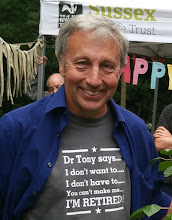I haven’t yet reviewed a book on my blog but this one was so good that I thought I would make a start. “Where the wild things were” looks pretty drab when you first pick it up but when you start reading it a fascinating story unfolds of how big fierce things rule the world (or should do).
We’ve all seen the nature programmes on TV. They are excellent and I am not one to criticise them. Good ones might tell you all about an animal – maybe giving you a year in its life. The very good programmes may tell you more about the habitat in which an animal lives. But there’s the rub – a habitat is generally portrayed as something an animal lives in. It is very rare for us to get a picture of how an animals shape the world they live in. This is a huge gap in the way nature conservation is put across to people - what we should be seeing is animals as integral parts of their habitat.
Animals often drive the ecology of an ecosystem rather than just live within it. For example large herbivores graze areas so, obviously they create grasslands, similarly beavers build dams, blocking rivers and so create wetlands. You can therefore see how animals impact on vegetation and so alter ecosystems. Large predators, however, are often just thought of as something that sits at the top of the food chain. We may think of them as a method of keeping the numbers of herbivores down, but surely a few lions or tigers wandering around cannot have much effect on what a forest looks like?
Stolzenburg, however, shows, in a clear, entertaining and readable way, how top predators are fundamental in shaping whole ecosystems, effectively driving the ecology of areas. Furthermore, he shows that many ecosystems around the world are in a tail-spin of degradation and collapse because they lack predators.
This is an excellent book. We may know that wolves are back in Yellowstone, USA, but nowhere else have I read such a clear explanation on how wolves have changed the behaviour of other species and in the process beneficially altered the vegetation. We may have seen cute pictures of sea otters off the Canadian coast but did you know that they eat large numbers of sea urchins and without otters sea urchin populations would explode leaving them to graze the marine kelp forests to destruction. So, centuries of hunting otter for fur actually resulted in the destruction of a major marine ecosystem.
He introduces us to concepts such as a “trophic cascade”, the idea that if you remove predators then the effects bounce around the ecosystem in unpredictable and destructive ways. For example when wolves were hunted to extinction in Yellowstone then, predictably, deer numbers exploded, vegetation became over-grazed and many plants and animals declined. Less predictably, without wolves, coyote populations increased which hunted Pronghorn Antelopes. When the wolves returned, the coyotes received a tough lesson in top-dog diplomacy! And Pronghorns increased. An interesting insight of how a predator can increase the population of a prey species. Also surprising was the effect on riverside vegetation – when the wolves came back the grazing animals avoided rivers as that is where they got ambushed. The result was less grazing alongside rivers and a huge flush of regenerating wetlands.
Examples pour out of this book developing a powerful argument to show the critical value of predators. From the effect of starfish on mussels to cougars on white-tailed deer, to coyotes on domestic cats, in each case the presence of a predator sends out ripples giving a richer, more diverse, more stable and better functioning ecosystem.
Discussions on what drives the ecology of ecosystems are always fascinating. The world is so diverse that most views are probably right somewhere – often the keystone species will be predators, often large grazers, sometimes ants, fungi, even midges! Stolzenburg makes an excellent case for predators.
Stolzenburg also does not shy away from “political” implications. The deepest resistance to the return of wolves in Yellowstone came from hunters who wanted the maximum number of docile deer that are easy to shoot. Killer whales are now eating otters and seals because we have killed off their main prey – the large whales. This is uncomfortable to both whaling commissions (unhappy that whaling could be damaging ecosystems) and conservationists (who consider over-fishing as the main cause of seal decline).
This book also boosts the case for re-introducing predators, or for carrying out management practices that mimic the effect of predators. Whole ecosystems are suffering, in Britain as anywhere, through lack of predators. We need them back for the health of our own environment, and if we do not get them back we need to find ways of controlling the things that top predators would have controlled.
Tuesday, 11 August 2009
Subscribe to:
Post Comments (Atom)

No comments:
Post a Comment